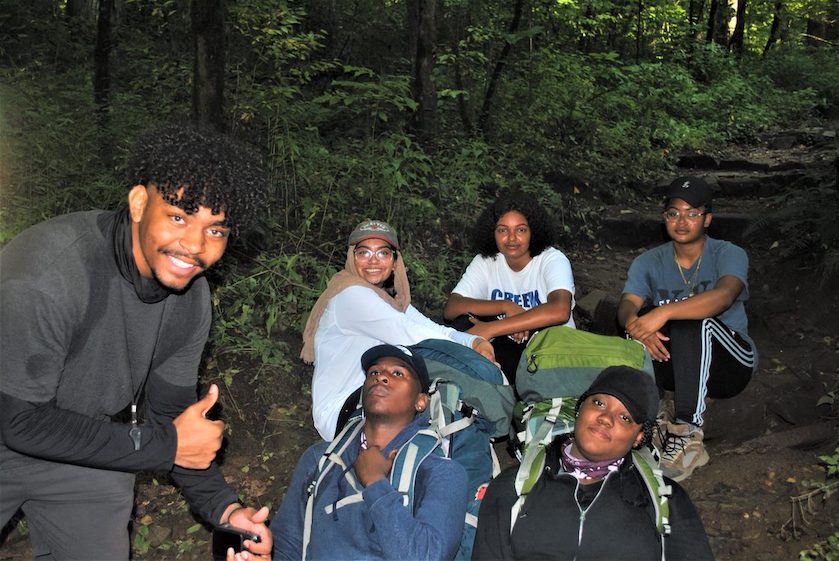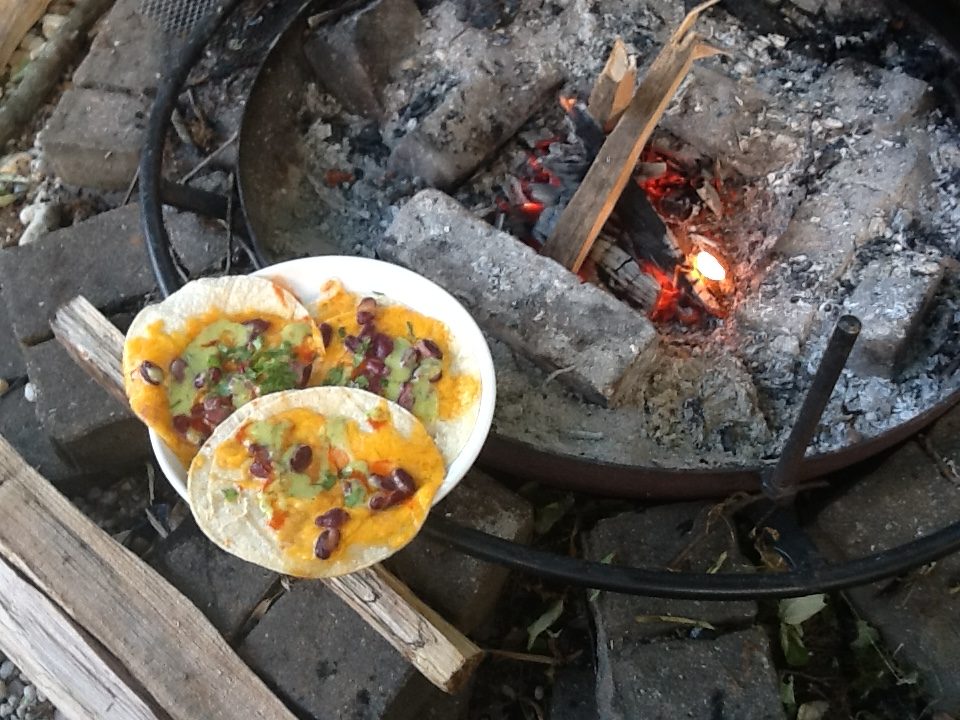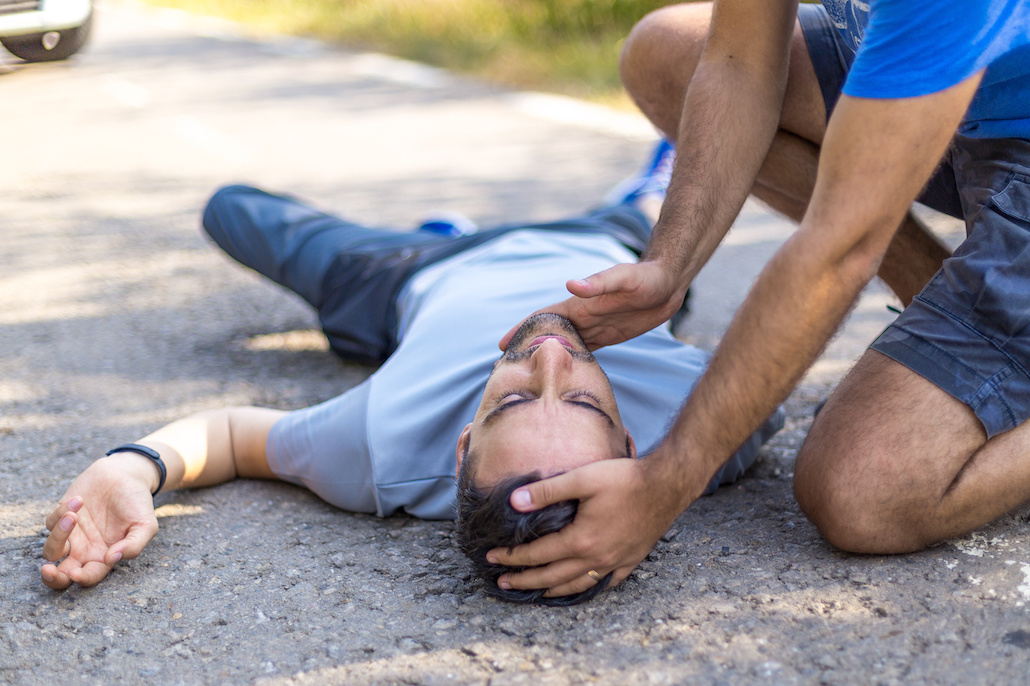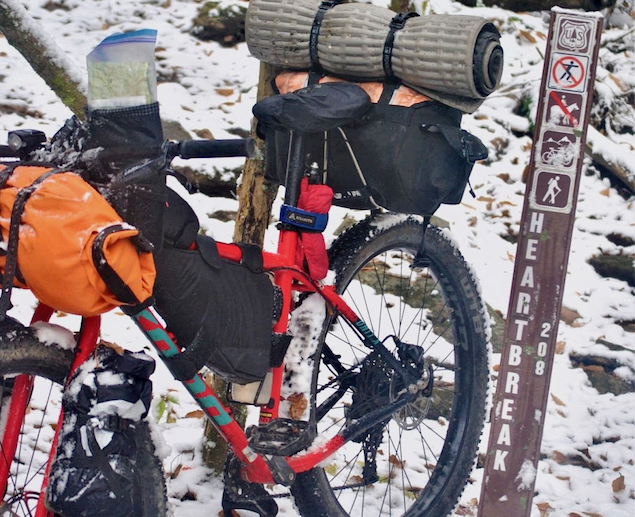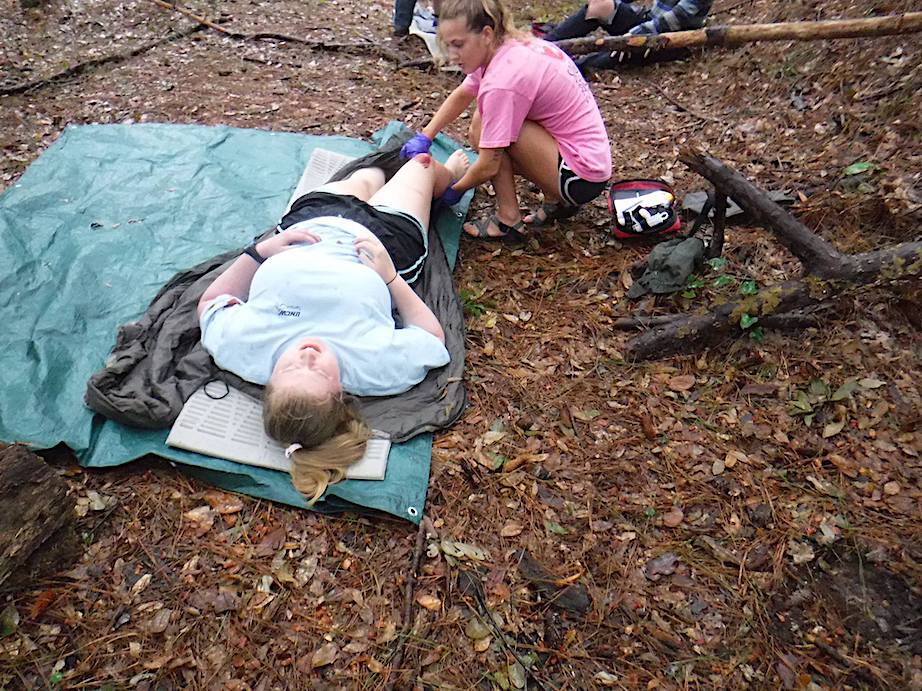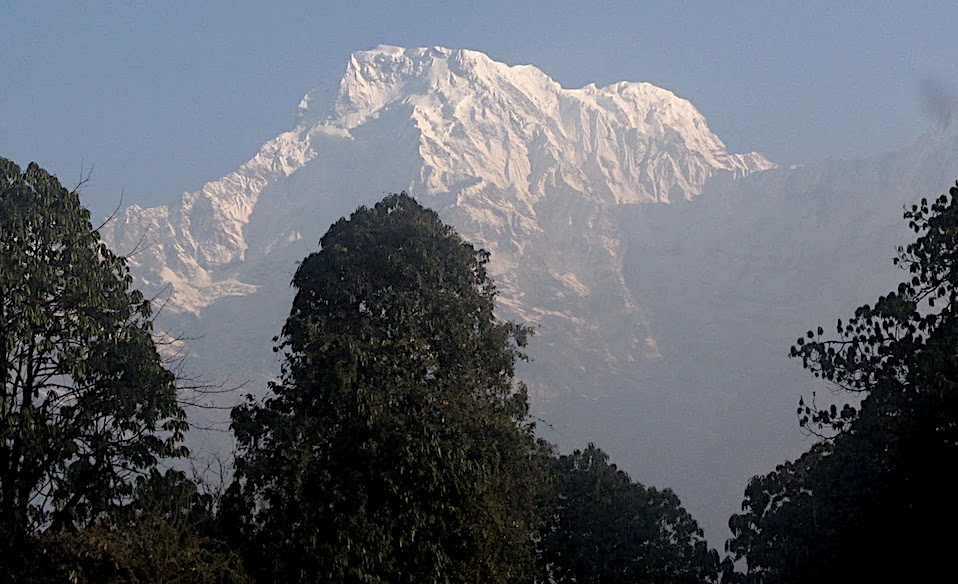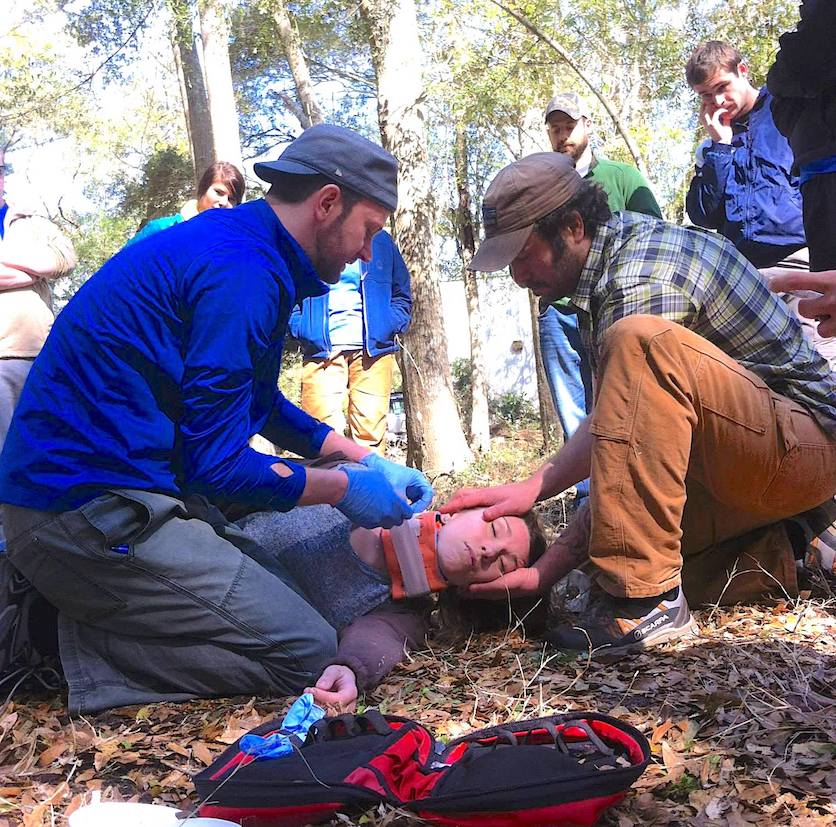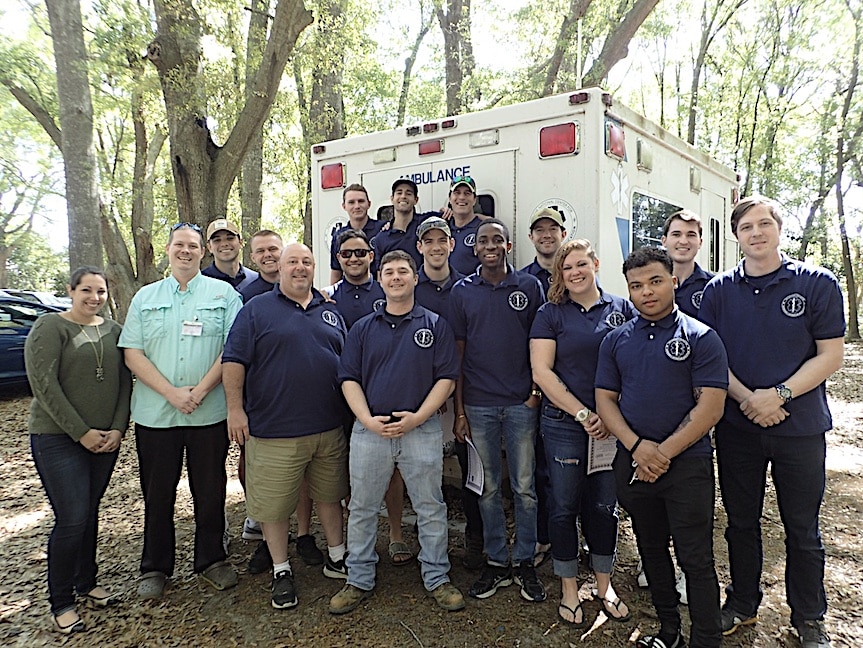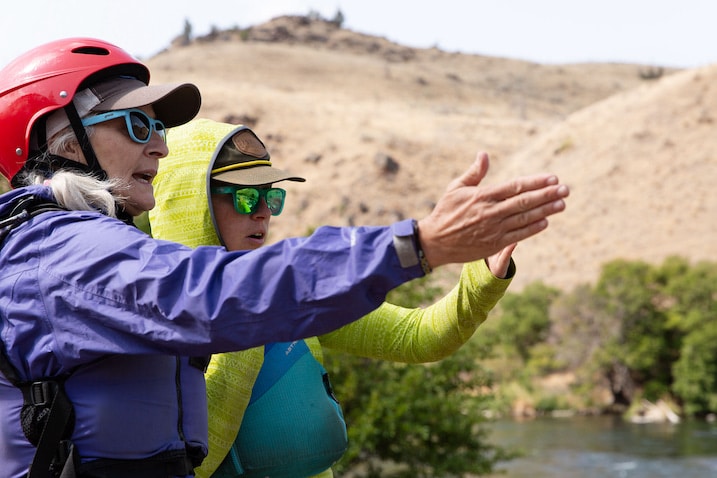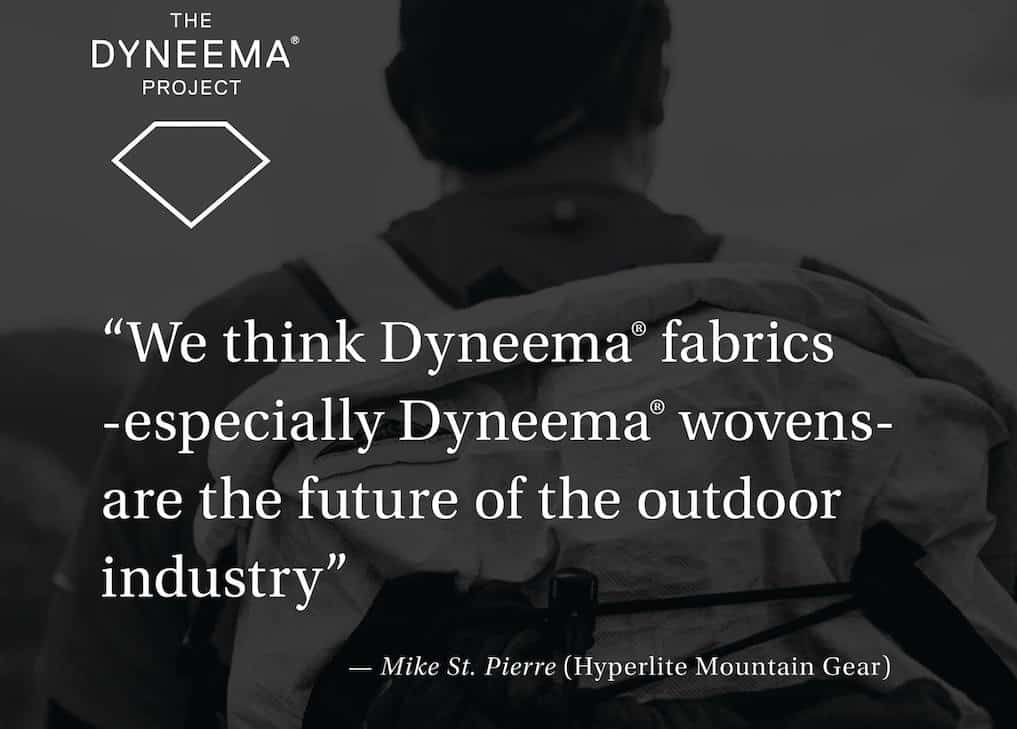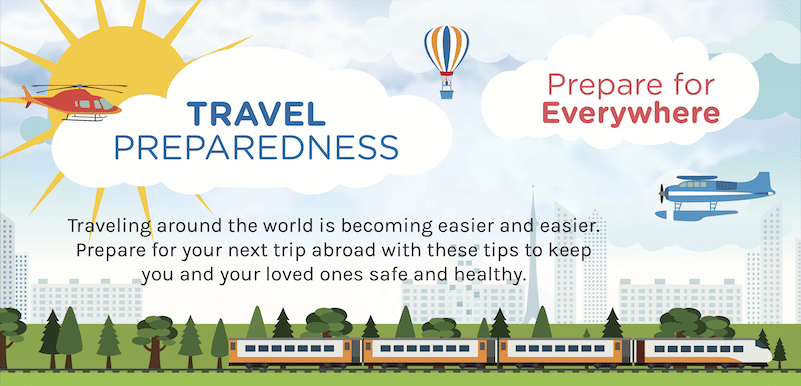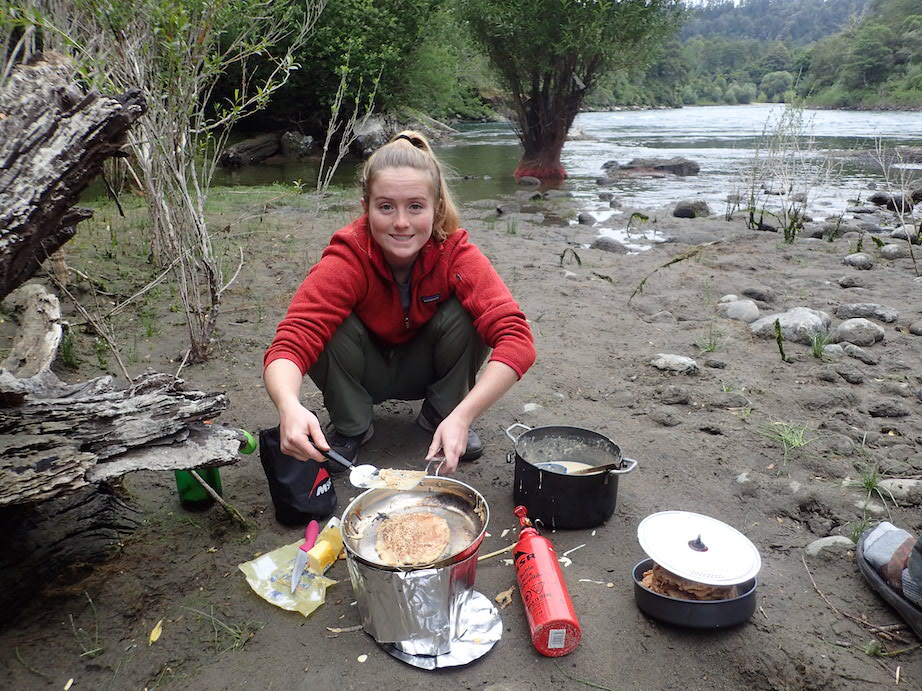NCOAE Blog
NCOAE Celebrates Black History Month with NCCU’s Cheatham-White Program
Custom ProgramsIt’s pouring rain, and some of North Carolina Central University’s custom outdoor education program participants slip into the knee-deep mud, briefly maintaining their balance, only to slide like baseball players down a short, navigable incline.
Stephen Mullaney, NCOAE’s director of school partnerships, quickly glances over to see how Christina is doing — just in time to see a huge grin from beneath her rain hood. That figures, he thinks.
Christina Garrett is a go-getter, no question about that. She is the Associate Director of University Scholars at North Carolina Central University (NCCU), one of about a hundred Historically Black Colleges and Universities (HBCUs) in the United States.
As Christina, NCCU students, and some of NCOAE wilderness field instructors continue their trek in the rain, she tells Stephen about her own outdoor experiences, including fishing with her father, visiting state parks, and her accomplishment of heading what is likely the first required wilderness orientation experience for incoming freshmen and transfer students at a Historically Black College/University.
Christina’s program, which is named the Cheatham-White Scholarship Program, was established in 2018 and provides academic scholarships based on merit. Focusing on students attending NCCU, the program was designed for exceptional student scholars who possess a range of interests, proficiency in both the arts and sciences, and who demonstrate leadership potential and a commitment to service.
Admittance to the scholarship-supported program includes tuition and fees, housing, meals, textbooks, a laptop, travel, and personal expenses. The generous scholarship also means four summers of enrichment and networking. That means travel — maybe even international travel.
Where NCOAE comes into the picture is at the (more…)
Adventures in Outdoor Cooking: Do it for Your Taste Buds
Wilderness CookingThe instructor-in-training for the day reaches into her pack, shakes her head and swears softly.
“We left a bottle of fuel at basecamp. Who do we call for resupply?”
Liz, NCOAE’s course director walks over to the instructor and looks into the canvas bag. Then she shrugs her shoulders and says, “There’s no one to call. Looks like we’ve only got fuel for three out of eight nights.”
Scanning the forest, Liz points to a pile of rocks on the ground where previous groups have built fires and says, “Collect wood, build a fire, cook dinner.”
A few days earlier, this same group was packing for an Instructor Training Course. Participants are educators who have been in the outdoor education and adventure industry for a few years and have a firm grasp on technical skills. We use the course to familiarize these future instructors with our curriculum, educational practices and other components that are unique to NCOAE.
So, when an Instructor Course group forgets to pack an important piece of gear — in this case fuel — we like to see how problem solving, creativity and ingenuity unfold to keep an expedition moving forward.
Now, with a fire started and a meal selected for the evening, it’s time to start cooking. These NCOAE instructors in training begin by building a potholder out of rocks, stirring up the coals, and blending ingredients together for the meal.
There’s little confusion, no drama, and the meal comes together because these educators have been practicing outdoor skills at home in their backyards as well as in outdoor settings like the one mentioned here.
Practice makes perfect
The way these participants upped their backcountry skills and calmly slapped together a great evening meal was to practice their “seeking game.”
It was back in the late 1990s when a neurologist named Jaak Panksepp coined the term “seeking system” in regard to (more…)
Six Tips on How Best to Respond to a Medical Emergency
Medical TrainingIt’s pretty well known that we here at The National Center for Outdoor & Adventure Education (NCOAE) are experts when it comes to training our students how to respond to medical emergencies in remote or wilderness settings. Less known is the fact that we also educate anyone interested in training that satisfies the eligibility requirements for the National Registry of Emergency Medical Technicians.
As a result, we teach our students to recognize that medical emergencies can happen anywhere and at any time. And it’s how we respond to those emergencies that makes all the difference in the world.
Below are tips in six categories — including safety, recognition, requesting help, patient communication, and being prepared — when handling a medical emergency.
Safety. Don’t be afraid to help, but don’t become part of the emergency. Use extreme caution near roadways or in hazardous environments. Take a few extra seconds to stop traffic or put on your life jacket.
Recognize that an emergency is happening. Whether you’re dealing with a friend or a stranger, if something seems wrong, ask if they are OK. When is something an “emergency?”
- Breathing: When someone is having trouble breathing, always consider it an emergency.
- Circulation: Many conditions, including heart attacks, can cause the heart to have difficulty pumping blood and can be rapidly fatal. Don’t wait, assume.
- Significant traumatic injuries: Falling from high places or being hit by a car are obvious examples of events that can cause significant injury. However, even if the person involved seems OK at first, assume there are unseen internal injuries.
- Neurologic problems: Any time the brain does not seem to be functioning correctly — even if it’s only mild confusion. Or if someone can’t use/feel one or more of their extremities. These are all emergency situations.
Call for help. This may be as simple as (more…)
Eastern Divide Trail Promises Bikepacking Heaven for Enthusiasts
BikepackingConsider what it is you like best about the Appalachian Trail or the Pacific Crest Trail, and then ask yourself this question, keeping in mind that, hypothetically, you were born decades earlier than you really were:
Benton MacKaye, the father of the Appalachian Trail — or perhaps Clinton Churchill Clarke, who conceived the notion of the Pacific Crest Trail — have asked you to scout the proposed routes to help with the writing of a guidebook.
Would you do it?
“Yes please,” would be my immediate response.
Granted, it’s a little late to do original onsite research for those two hike-thru heavens, but let’s move ahead to the 21st century and Logan Watts. A decade ago, from his home in the mountains of North Carolina, Logan launched a website called Pedaling Nowhere, which has since become BikePacking.com — a site has garnered an enormous following.
(If you’re unfamiliar with the term or activity, according to the editors of BackPacking.com. bikepacking is the “synthesis of all-terrain cycling and self-supported backpacking. It evokes the freedom of multi-day backcountry hiking and travel off the beaten path, but with the range and thrill of riding a nimble bicycle. It’s about venturing further into places less traveled, both near and far, via singletrack trails, gravel, and forgotten dirt roads, carrying the essential gear, and not much more.”)
Getting to Know Bikepacking.com
BackPacking.com started out as a place to share bikepacking stories, product review and profiles of people, their bikes and the routes they were riding, and by 2014, as more and more routes were catalogued, readers looked forward to everything from challenging and life-changing expeditions to day trips that, by the way, can also be life changing.
Bikepacking’s following grew to a point where a print journal — The Bikepacking Journal — was launched (which is now published in April and October of each year), and bikepacking “collective” was formed, which has grown to have enormous influence on the bike industry.
Many of the routes you can find on the website were originally published by (more…)
Eastern Divide Trail Promises Bikepacking Heaven for Enthusiasts
BikepackingConsider what it is you like best about the Appalachian Trail or the Pacific Crest Trail, and then ask yourself this question, keeping in mind that, hypothetically, you were born decades earlier than you really were:
Benton MacKaye, the father of the Appalachian Trail — or perhaps Clinton Churchill Clarke, who conceived the notion of the Pacific Crest Trail — have asked you to scout the proposed routes to help with the writing of a guidebook.
Would you do it?
“Yes please,” would be my immediate response.
Granted, it’s a little late to do original onsite research for those two hike-thru heavens, but let’s move ahead to the 21st century and Logan Watts. A decade ago, from his home in the mountains of North Carolina, Logan launched a website called Pedaling Nowhere, which has since become BikePacking.com — a site has garnered an enormous following.
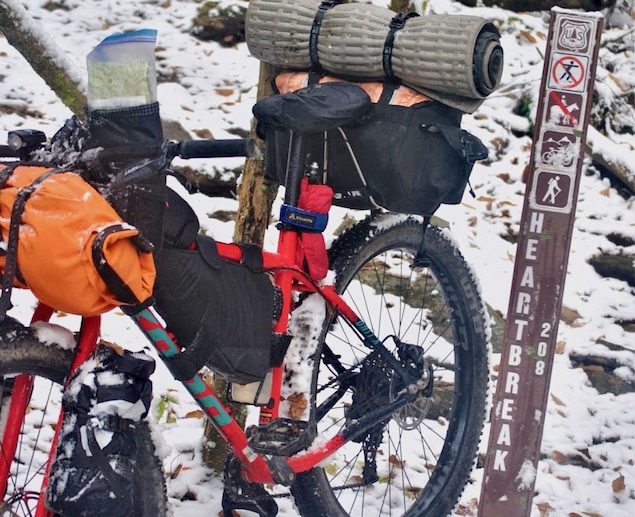
(If you’re unfamiliar with the term or activity, according to the editors of BackPacking.com. bikepacking is the “synthesis of all-terrain cycling and self-supported backpacking. It evokes the freedom of multi-day backcountry hiking and travel off the beaten path, but with the range and thrill of riding a nimble bicycle. It’s about venturing further into places less traveled, both near and far, via singletrack trails, gravel, and forgotten dirt roads, carrying the essential gear, and not much more.”)
Getting to Know Bikepacking.com
BackPacking.com started out as a place to share bikepacking stories, product review and profiles of people, their bikes and the routes they were riding, and by 2014, as more and more routes were catalogued, readers looked forward to everything from challenging and life-changing expeditions to day trips that, by the way, can also be life changing.
Bikepacking’s following grew to a point where a print journal — The Bikepacking Journal — was launched (which is now published in April and October of each year), and bikepacking “collective” was formed, which has grown to have enormous influence on the bike industry.
Many of the routes you can find on the website were originally published by
(more…)Why Become a Wilderness First Responder?
Wilderness First Responder TrainingFor those outdoor education organizations — or for those enthusiasts who live for a well-planned wilderness experience — the inclusion of a Wilderness First Responder (WFR) on the trail brings an additional layer of risk mitigation to any backcountry experience.
As for the question posed in the headline above, one of the primary reasons for becoming a Wilderness First Responder by earning your WFR certification, is the demand for highly trained and prepared educators and guides.
When you’re prepared to deal with medical emergencies in remote wilderness areas (locations where emergency response personnel may be difficult to reach or significantly delayed in arriving), you can not only breathe a sigh of relief; you can rest assured that you have someone in the group with the critical thinking skills and medical knowledge to help assess the situation and then properly manage the team if things go wrong.
What Does WFR Certification Entail?
Here’s what you should learn during a Wilderness First Responder course:
- Basic first aid skills, including bleeding control and wound care, splinting, and CPR.
- How to assess a patient and pinpoint any issues that compromise optimal health.
- The basic anatomy and pathophysiology of common medical problems. and injuries including shock, internal bleeding, dehydration, and infection.
- How to differentiate between true emergencies and more routine medical complaints.
- What to expect and how to proceed when you have to stay with your patient for hours or days before help arrives or an evacuation can occur.
- Evacuation guidelines and techniques.
Who Normally Takes a WFR Course?
Many professional outdoor industry businesses — including (more…)
At NCOAE, Partnerships Keep Us Outside and Global
About NCOAEOne tree doesn’t offer the strength of a forest, just as one organization can’t lead an entire industry.
According to others, we here at The National Center for Outdoor & Adventure Education (NCOAE) have distinguished ourselves as outdoor and adventure education industry leaders. But without collaborations, our ability to be creators and innovators would be difficult — if not impossible to achieve.
Since 2009, we have sought out ways to collaborate, learn, and lead with others. As a result, partnerships have taken us around the globe and helped us grow, and we happily play it forward, or backward or sideways to help our partners and others do the same.
As the calendar runs out in 2021 and we look ahead toward 2022, we see our biggest year yet on the horizon. On the agenda are courses, trainings, expeditions, and custom outdoor education programs that vary in length from three days to three months — all of which focus on technical outdoor and personal development skills. These include mountaineering, whitewater rafting, rock climbing, backpacking, surfing, sea kayaking, remote backcountry travel and camping, and of course… team building.
So, how exactly do partnership and collaborations with like-minded organizations help us grow? As we began working with public, private, and independent schools over 10 years ago, the word spread about our programming, curriculum, depth of instruction, and track record of facilitating programs that shifted students’ lives, school cultures, and even started to redefine communities.
For example, our collaboration with (more…)
Op-Ed: Has the Time Come to Standardize Wilderness Medicine Education and Training?
Wilderness Medicine TrainingThere is no shortage of wilderness medicine education providers in this country. From organizations that offer education and training for Wilderness First Responder (WFR) and Wilderness First Aid (WFA) certifications to those that offer train-the-trainer programs, a simple online search reveals a ton of options — especially when the search is focused on a specific geographical region.
What’s striking about all the wilderness medicine training and certification taking place is that none of it is nationally regulated. None of it adheres to commonly accepted industry standards that govern what’s being taught or how wilderness medicine education and training are being delivered. On the other hand, the training and certification EMTs receive is regulated on a state-by-state level and must meet minimum requirements as set by the National Highway Traffic Safety Administration (NHTSA).
Wilderness medicine training, while loosely adhering to a similar curriculum, is officially overseen by, well, no one. That being said, standardization and oversight aren’t completely absent. Several organizations have attempted to fill the void with a variety of education programs, courses, guidelines, accreditations, and oversight committees.
A Mismash in the Making
Historically speaking, first on the list is the Wilderness Medical Society (WMS) — a nonprofit founded in the early 1980s to encourage, foster, support, and conduct activities that improve the scientific knowledge of human health activities in a wilderness environment. WMS offers three types of advanced wilderness medicine-related certification that have a “continuing education” focus and accreditation connection. The organization’s Fellowship in the Academy of Wilderness Medicine (FAWM), Diploma in Mountain Medicine (DiMM), and Diploma in Diving and Marine Medicine (DiDMM) are all provided in accordance with standards set in part by the Accreditation Council for Continuing Medical Education (ACCME).
There’s also the fledgling Wilderness Medicine Education Collaborative (WMEC) — an ad hoc group of medical educators whose interest in providing guidance on content for wilderness medicine courses has resulted in the creation of minimum guidelines and scope of practice (SOP) documentation for Wilderness First Aid (WFA), Wilderness Advanced First Aid / Advanced Wilderness First Aid(WAFA/AWFA), and Wilderness First Responder (WFR) training. While the work of the collaborative (whose members include leaders from SOLO Wilderness Medicine, Wilderness Medical Associates International, and NOLS Wilderness Medicine, among others) has resulted in a robust set of SOPs, its influence is nonexistent outside those of us who actively choose to look beyond ourselves for best practices. In other words, without accreditation, there’s no real motivation for anyone offering wilderness medicine education to seek out the WMEC. And without a formal structure and an administrative arm, the WMEC has no enforceable authority or meaningful influence.
Speaking of accreditation, closer to home for those us in outdoor and experiential education, following a rapid increase in the number of adventure programs in the late 1980s and early 1990s, it became imperative that outdoor experiential education programs develop standards of program quality, professional behavior, and appropriate risk management. Enter the Association for Experiential Education (AEE), which responded to that need in the early 1990s by developing comprehensive standards for common practices in the adventure education industry, becoming the nation’s first recognized accreditation provider focused on outdoor and adventure-based experiential education programming.
(more…)Exactly What Is It That an EMT Does?
EMT TrainingDepending on where you live, you may see them every day or just when there’s a fire, police, or medical emergency where you are. Regardless of the frequency with which you see them, you may be wondering — what exactly does an EMT (Emergency Medical Technician) do?
EMTs are not just “ambulance drivers,” although that’s certainly a critical part of their occupation. An Emergency Medical Technician is a trained and certified medical provider who has demonstrated competency in basic pre-hospital medical care.
For EMTs and patients, an ambulance is more than transportation to the hospital. It’s a mobile mini-medical center squeezed into the back of a moving vehicle where a skilled team of pre-hospital healthcare providers perform a variety of life-saving medical interventions that save lives every day in every community.
What an EMT Must Learn
While nearly anyone can attempt to become an EMT, in order to qualify to take and pass the National Registry of Emergency Medical Technicians certification exam, candidates must first complete an approved EMS education program. In that program, EMT candidates’ study and learn a lot of things, including:
(more…)Proper Water Treatment Needs to be a Priority in the Backcountry
Wilderness CookingWhile it’s true that some water sources you encounter in the outdoors are safe, know that drinking from even the most pristine looking stream or river can make you sick. There might be unseen runoff from industry, agriculture, livestock, and wildlife, and these can contribute bacteria, chemicals, and other contaminants to the very water you believe is safe to drink.
Which means you should always treat all outdoor water sources before consuming. If that recommendation is confusing or sounds somewhat limiting, consider the following: To guarantee your continued health while recreating in the outdoors, whenever possible, you should bring your own water from a known source. That includes tap water from home or bottled water from the store. The only other option is to practice water treatment techniques.
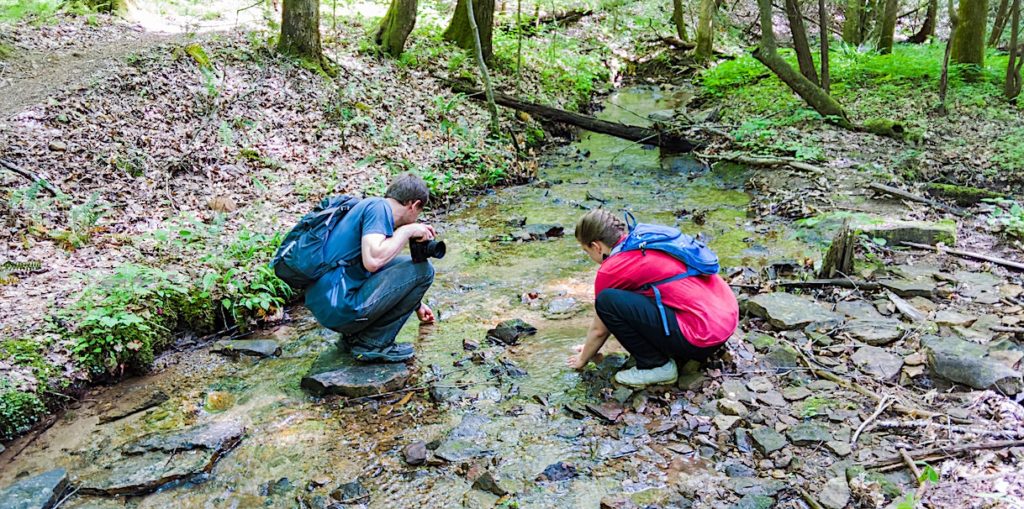
Here are some common ways to treat water:
BOILING
This method is one of the simplest and least expensive ways to treat water in the backcountry.
- Simply fill your water pot from your water source, place your pot on your stove, then bring to a full rolling boil.
- Once your water has come to a full rolling boil, allow to continue boiling for another minute to eliminate bacteria, protozoa, and some viruses.
- And if you find yourself at a higher altitude (above 6,500 feet), add another three minutes to that boiling time.
- However, boiling is not the best method when you know your water is contaminated with runoff from agriculture or chemicals.
(more…)Warning: Boiling water burns cooking fuel. You might consider saving cooking fuel for cooking and perhaps build a wood fire — assuming your backcountry permit or local ordinances allow for it — to boil water for drinking.
Discover Solace in the Outdoors After Months Isolating Indoors
InspirationYou sit. The clock is ticking. You hear only the clock. And all the stress and anxiety vanish.
Solace.
Laughing with friends around a backyard campfire on a Friday night. Distant traffic and an occasional train whistle provide the soundtrack. The weight of the week disappears.
Solace.
Sitting quietly on a rock on Day 20 of a 30-day solo backpacking trip. Hearing birds overhead and seeing every pine needle with clarity.
Solace and solitude.
Solace and solitude, however, do not mean the same thing.
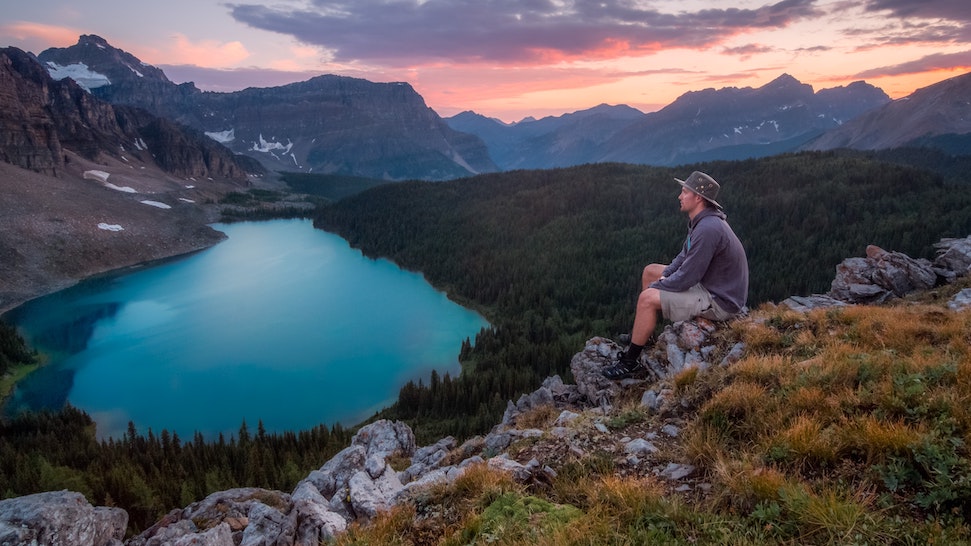
Solace is the finding of comfort in times of distress. Solitude is being alone.
For the past year and a half, most of us have tackled a mountain of experiences and emotions related to the global health pandemic. We know solitude. Head in hands, confused, feeling pain, sorrow or anxiety, we have all been bombarded by the thought that something has got to change.
Want to know my take on this universally felt emotion? Find yourself some solace. Sure, maybe solitude seekers have an easier go of it. That’s because avoidance and denial are always the easy way out. What I know is that it has been a long time and a hard time for many of us. And many of us are now seeking solace.
In reaching for stone, wood, water, and feather, I found my own edges softening, scars fading.
Heather Durham
Getting outdoors — either alone or with close friends — has always been a way for me to find solace. Here at The National Center for Outdoor & Adventure Education (NCOAE), we design a variety of outdoor programs that can provide that which you seek. We work with all types of schools, groups, and organizations to provide many radically different outcomes.
And one thing that is common to all of our courses is what we call the “Summit.” Ask any NCOAE instructor or participant what they think was the most powerful experience that shaped the group, provided introspection, and helped keep them moving in a positive direction when they returned home. Most will immediately say, “Summit.”
(more…)It Took a Pandemic to Shine the Spotlight on Our Nation’s EMTs
EMT TrainingEmergency Medical Services personnel (EMS) have been on the front lines of the COVID health pandemic for 18 months now, with no end in sight. These key healthcare providers continue to adapt to an ever-changing work environment and thus far have maintained a high level of care.
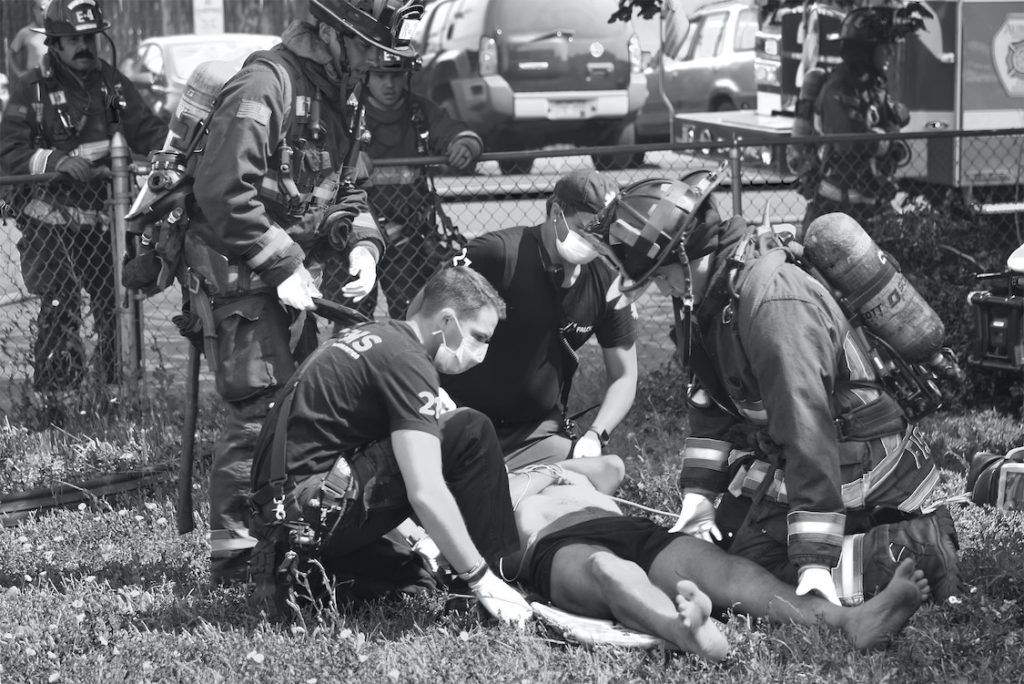
If you’re thinking of entering the field of EMS, know this: The need is greater than ever. That given, what should you know about EMS in the era of COVID? Below are thoughts from the experts here at The National Center for Outdoor & Adventure Education (NCOAE), where we offer a number of training options to prepare future EMTs for what lies ahead.
To get us started, let’s take a look at PPEs.
Personal Protective Equipment (PPE): For years most EMS providers considered “PPE” to mean “Exam Gloves.” No longer. Today, you’ll most likely be required to wear an N-95 respirator and eye protection for an entire 12-hour shift. You can probably also add a gown and potentially additional layers to that ensemble. It’s hot and uncomfortable and no one enjoys it. But we’ve shown it can be done, and that it’s being done to good effect.
(more…)Planning Begins Now for 2022 Pacific Northwest Adventures
Custom ProgramsWell, it’s official. We’ve just wrapped up and put a bow around another successful season of adventure-based programming in the Pacific Northwest, with all of our expeditions originated from our base of operations in Maupin, Ore., alongside the wild and scenic Deschutes River.
And, of course, we here at The National Center for Outdoor & Adventure Education (NCOAE) are already making big plans for next season’s explorations of the Pacific Northwest. Our custom trips feature a range of course options to fit every organization’s or adventurer’s schedule, all set against the background of some of this country’s most breathtaking terrain — the rugged and remote Cascade Mountains. During your trip, you’ll be guided through deep canyons, hike along alpine meadows, traverse cold-mountain streams, explore cascading waterfalls, and enjoy remote mountain passes.
For the 2022 season — in addition to custom programs for schools, youth organizations, and other groups — we continue to offer a range of (more…)
Dyneema: A Lightweight Fabric for Your Outdoor Gear
Outdoor EquipmentEvery now and then, we like to introduce — or expand upon — a new product or material that outdoor educators might be interested in. By keeping our ear to the ground and paying attention to what’s impacting the outdoor industry, our peers in the adventure-based, outdoor education community can continue to be informed about what’s next.
Today, we’re pleased to shed some light on an ultra-high molecular weight polyethylene fiber named Dyneema.
What is Dyneema and why should I care?
Dyneema is a new age fiber that stops bullets in law enforcement gear, provides lighter weight jibs and thus faster speeds on sailboats, and gives tents and backpacks incredible strength while dramatically reducing weight. Oh, and it floats in water.
Dyneema is solely manufactured by Royal DSM, a Netherlands-based firm that’s recognized as one of the oldest players in the European chemical industry. Dyneema itself is a superlight fiber that’s up to 15 times stronger than steel by weight. Its base — the ultra-high-molecular-weight polyethylene — makes it the strongest of any thermoplastic.
And while it’s been used in climbing gear for quite some time — often referred to as Spectra or Dynex — you would have been hard pressed to find Dyneema products like tents and backpacks until just a few years ago. But today, there are entire companies that use only Dyneema, building their product lines around this highly touted, lightweight fabric.
What are the benefits of Dyneema in the backcountry?
In the outdoor adventure segment, manufacturers using Dyneema have made great strides in several product areas, including tents and tarps. Due to its strength-to-weight ratio, it offers the lightest weight in the industry with the added bonus of being completely waterproof with no water absorption.
In active apparel and footwear, the ultralight category is coming up with a variety of strength-added offerings, including hiking boots. Other advantages include: (more…)
Safety Considerations for Adventure Travel in Foreign Countries
UncategorizedThere are few activities that provide a greater explosion of sense and emotions than putting foot in a new land — a foreign place where you have to navigate language, landscape, and culture practically the instant you arrive.
Memories of stepping off a plane and heading out of the airport in Kathmandu, Port Au Prince, and Guatemala are forever stored and accessible in my brain’s happy file. Prominent among these are the new smells, the architecture, the people, and the only slightly realization that you’re not in Kansas anymore. Or North Carolina or wherever it is you call home.
And the places to which we travel, and the experience we take away from those adventures are tied directly to how safe we feel while out exploring.
As more of us prepare to climb on planes, trains, and boats again, NCOAE wants to share some of the safety and risk mitigation tips we have learned along the way when traveling far from home with clients from all walks of life.
With the tips we offer below, the focus is on adventure travel and ecotourism. Don’t neglect to research basic travel tips as well.
Let’s get started:
(more…)Update from NCOAE Spinoff — Education Without Walls
Education Without WallsIf you’re a regular reader of our blog, you may recall that Education Without Walls (EWOW) began more than a decade ago here at The National Center for Outdoor & Adventure Education (NCOAE).
Today, EWOW has become a successful organization — a self-sustaining not-for-profit complete with its own administrative staff, board of directors, programs, and funders… all of which are focused on providing academic and life skills guidance for motivated teens with financial need.
With that as background, the rest of today’s post focuses on what this fledgling organization has been up to since spinning off from NCOAE, and what’s on its horizon.
The Big 24
The organization’s first big fundraising event — The Big 24, which aims to raise enough funds to award one-year scholarships to 24 deserving students — begins this Sunday (Aug. 15) and runs through Oct. 15, culminating with a first-ever “Evening Without Walls” fundraising event.
For information on The Big 24 and how you can help, please The Big 24 webpage or contact EWOW’s Executive Director, Celine Adair, MA, LMFT by email or by calling (910) 515-9157.
Summer Expeditions
Education Without Walls has always been focused on merging meaningful outdoor adventures with ongoing mentorship to assist aspiring students in identifying and accomplishing their (more…)
The Three Bears: Part 3 — Decision Time for the Trailbike Rider
WildlifeEditor’s Note: Below is final part in Stephen Mullaney’s three-part series of essays about encounters with bears in the backcountry. The first essay in the series recants the shock Stephen experienced with one particular bear encounter, while the second essay in this series attempts to find humor in a persistent bear taking up quarters in an NCOAE camp late at night. This time around, Stephen — who serves as Director of School Partnerships here at The National Center for Outdoor & Adventure Education (NCOAE) — writes about a timing issue.
Decision Time for the Trailbike Rider
When NCOAE offers larger courses or custom outdoor education courses, we try to have a floater in the field. The floater is an instructor who knows the course area, can navigate to multiple groups in a single day, and has the ability to be flexible and help out when groups are in need of extra support.
I enjoy being a floater because it allows me to see the NCOAE field staff in action. To watch an NCOAE instructor teach is inspiring to me. It also has the added benefit of allowing me to discover different approaches to teaching our curriculum. As a result, being a floater is akin to real-time professional development.
On one particular wilderness course for which I was the floater, we 11 crews/groups in the field. Because of the distance between the groups, the terrain that would need to be traversed, and the need to reach groups quickly, I figured using a trail bike was a no brainer. I could get to each group every four days and still be able to respond to any group that may need outside support in a quicker fashion.
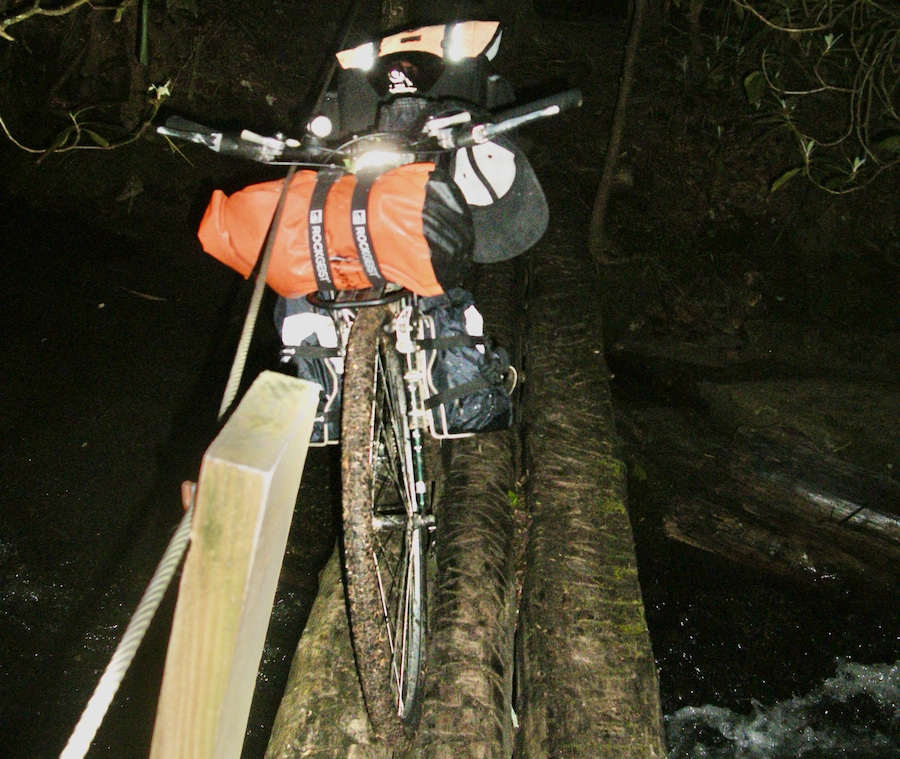
Each day I woke up, left the crew with which I had spent the night, and headed off to meet the next crew before they had even had their breakfast. Then I was off to the next group before lunch, and I usually showed up to meet my final crew for the day a little before dark. Or very much after dark depending on circumstances.
(more…)The Three Bears: Part 2 — Some Confrontations Can Be Humorous
WildlifeEditor’s Note: In this, the second installment of “The Three Bears,” we’ll hear from NCOAE staffer Stephen Mullaney tell yet another true tale about confrontations with bears. In this post, he’ll attempt to find the humor in a persistent bear taking up quarters in an NCOAE camp late at night. But let’s let Stephen tell the story:
The spot where this particular bear adventure occurred is conveniently located near an area we used for climbing instruction. Unfortunately, the site is also known for its occasional bear activity, and with proper planning and risk mitigation, can be safely used for that purpose. This was an outdoor education industry training trip, and all participants were adults with lots of experience guiding in the backcountry.
We had finished cleaning up camp, putting our bear canisters well away from campsite and had settled down for a well-deserved night of sleep after a long day of climbing. I laid down in my hammock and was asleep in an instant.
Having spent an incredible number of nights sleeping in the woods, I have learned the difference between a stick or branch falling, being blown by the wind or being cracked in half under the weight of a large animal.
The crack that woke me up was the crack made by the weight of a large animal.
I rolled over, lifted my tarp, and took stock of the situation. I didn’t get out my hammock, because I didn’t want to fully wake up if everything looked copacetic. No more sound means more sleep, and I rolled over and fell back to sleep.
Crack!
There it was again.
I repeated my previously approach of taking a peek while buried in my hammock. However this time the cracking continued, and I was able to (more…)
The Three Bears: Tales of Terror and Trepidation — Part 1 “The Shock”
WildlifeWhen folks find out that my work often takes me into the backcountry, one of the first questions they usually ask me is, “Have you ever had a run-in with a bear — a bear encounter?”
After I tell them that I have had run-ins with bears in the backcountry, they ask what’s that’s like. And that’s when I share that there are many emotions attached to an encounter with a bear in the wilderness, ranging from shock, to humor, to the sudden and unexpected “meet and greet” where you wonder, “Am I going to have to physically engage with this bear?”
First up in this three-part series on bear encounters in the backcountry is a true story about ashocking bear encounter.
A Shocking Bear Encounter
It was Day Two on a multi-day backcountry expedition when someone in the group needed to stop and use the facilities, meaning off the side of the trail. The hiker asked for the “Poop Kit,” which contains hand sanitizer, a trowel to dig a hole and everything else needed for a semi-comfortable sitting.
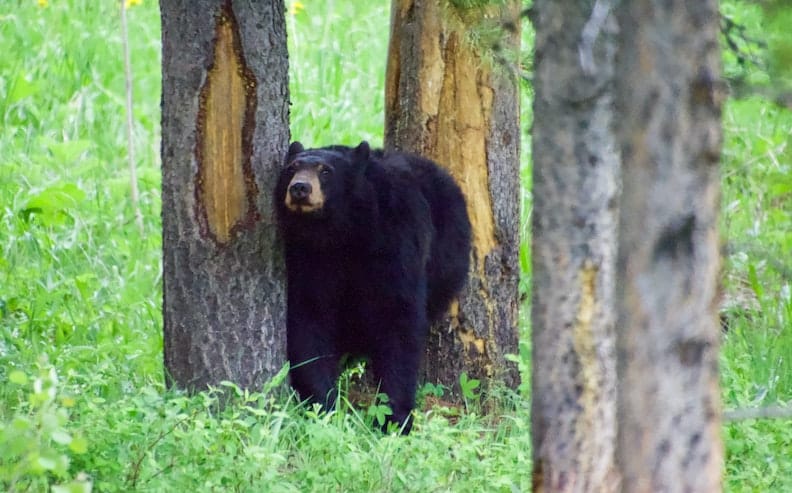
Problems arose when no one could find the kit. As an aside, when traveling as a group, each participant is responsible for carrying the same communal gear each day — that way, nothing gets lost. So, who had been carrying the kit for the entire trip?
A voice spoke up, “I’m supposed to have it, but it’s not in my bag.”
Someone else said, “I saw it by the fire ring this morning while we were getting ready to head out.”
Not too happy, I looked at my co-leader and told him, “One of us needs to hike back and get it while the other gets the group into camp.” I lost the coin toss, and prepared to head back to get the kit. Wanting to travel light, I hung my backpack up in a tree, grabbed a snack and a bottle of water and headed the four miles back to the previous night’s campsite.
(more…)Making Dehydrated Delicious: 4 Quick Backcountry Recipes
Wilderness CookingHere at The National Center for Outdoor & Adventure Education, we’re known for bringing gourmet meals to the wilderness. And since we carry all our food either on our backs or in our boats, we try to pack ingredients that begin in their lightweight dehydrated form. That makes for an easier time on the trail, and it leaves room in our packs for fresh vegetables and fruit to mix things up.
Meals in the backcountry offer a variety of options — from meat and grains to fresh baked bread and pizza made from scratch. Our students learn to cook meals on the trail, often developing cooking skills that they can bring home to the front country.
Here are some our staff members’ and students’ favorites from the trail that you might want to prep and cook on your next outdoor adventure:
Blueberry Pancakes
Who doesn’t like pancakes first thing in the morning? This trail-proven recipe is sure to get your day started on the right footing. Blueberries, after all, are more than just sweet and nutritious — they’re also known to play a role in reducing muscle damage, especially after strenuous exercise.
(more…)TALK TO US
Have any further questions about our courses, what you’ll learn, or what else to expect? Contact us, we’re here to help!
